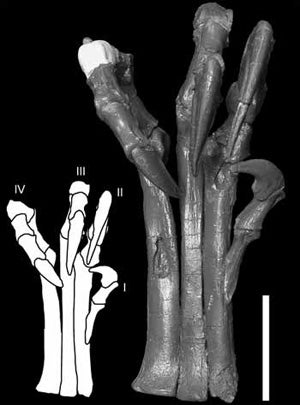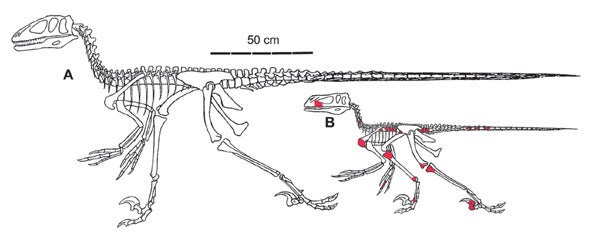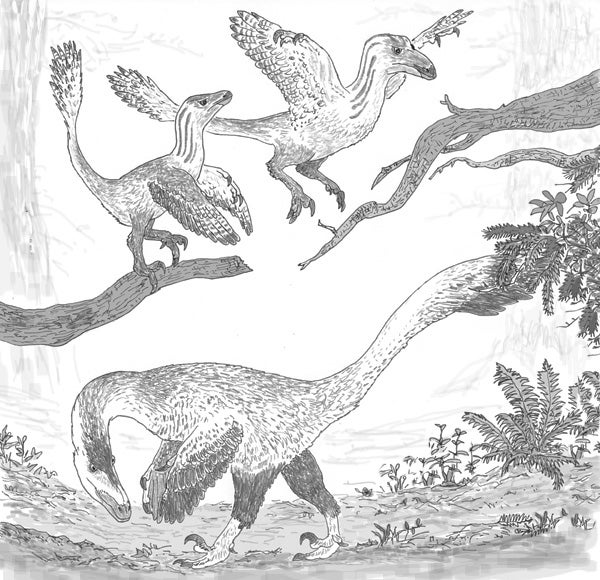This article was published in Scientific American’s former blog network and reflects the views of the author, not necessarily those of Scientific American
Regular readers (as well as those who keep up to speed on Mesozoic dinosaur literature) will be familiar with the assorted to-ings and fro-ings that have concerned the debate over tree-climbing in non-bird theropods. A popular idea among dinosaur specialists is that non-bird theropods were ground-bound animals that didn’t climb at all. Quite what this means for long-fingered, gliding weirdos like Epidendrosaurus and Yi qi and little gliders like Microraptor isn’t clear (what – they never climbed, ever?), and I’m among those who think that members of the more bird-like maniraptoran lineages were capable of at least some clambering and climbing (Naish 2000a, b, Birn-Jeffery et al. 2012).

Flexion in the foot of Deinonychus as reconstructed by Fowler et al. (2011). Dinosaurs like this could easily grasp things with their feet. Good for predation, but potentially good for climbing too.
Several studies of foot claw curvature in dromaeosaurids are relevant to the possibility of a climbing ability in these animals. Manning et al. (2006) posited use of the dromaeosaurid sickle claw as a ‘climbing crampon’ (albeit used on prey!!!), Parsons & Parson (2009) interpreted claw curvature in Deinonychus as being most similar to that of tree-climbing birds, Fowler et al. (2011) described and illustrated a grasping function for the foot of Deinonychus (linked by them to prey restraint, but obviously relevant to the possibility of climbing and perching as well), and Birn-Jeffery et al. (2012) found Deinonychus to fall into the ‘climber’ cluster in an analysis of claw curvature and how it matches (or doesn’t) with lifestyle. And of course there are also those authors who have always pictured dromaeosaurids (and other coelurosaurs) as scansorial, like Chatterjee (1997, 1999).
On supporting science journalism
If you're enjoying this article, consider supporting our award-winning journalism by subscribing. By purchasing a subscription you are helping to ensure the future of impactful stories about the discoveries and ideas shaping our world today.
It’s with this discussion in the background that we now turn to Parsons & Parsons’s (2015) new study on a specimen of Deinonychus from the famous Lower Cretaceous Cloverly Formation of Montana. The specimen concerned (MCZ 8791, collected in 1982) is identified by the authors as a juvenile Deinonychus, said to be about a year old on the basis of the single growth line observed in its sectioned radius. Its striated external bone texture also demonstrates juvenile status. By comparing the proportions of MCZ 8791 with those of an adult Deinonychus, Parsons & Parsons’s (2015) calculate a total length of 1.3 m and a mass of 6.9-8.7 kg.

Diagram from Parsons & Parsons (2015) showing (A) adult Deinonychus, mostly based on Ostrom's work, and (B) the juvenile represented by MCZ 8791, the red sections being those parts of the skeleton that are known.
Several features show that this juvenile animal differed from adult specimens of Deinonychus with respect to such things as the comparative length of the maxilla, the depth of the articular bone in the lower jaw, the curvature of the teeth and so on. But more interesting is the fact that Parsons & Parsons’s (2015) also describe proportionally larger limbs and limb girdles in the juvenile (and associated details of forelimb bone shape and pectoral glenoid form) which (drumroll) is interpreted as indicating some sort of flight ability in this juvenile.
Yes, they actually suggest that MCZ 8791 and, by extension, other juvenile Deinonychus individuals were flight-capable animals that could flap, and that an ability to fly was present in juveniles but lost as the animals matured. We might conclude from this that they underwent an ontogenetic niche shift, switching lifestyles as they grew up. If you have a good memory and make a habit of reading the Tet Zoo comments, you might recognise this idea as a possibility repeatedly suggested by regular commenter Jerzy (whose real identity remains safely anonymous, muhaha).

As an adult, Deinonychus forages on the ground. But as a juvenile, it climbs, flaps and clambers about among the branches. A speculative life reconstruction by Darren Naish.
If the juveniles of Deinonychus were flapping flyers – and given that animals surrounding Deinonychus in the phylogenetic tree were perhaps gliders or flyers (like Microraptor and Archaeopteryx) – might we have evidence here that all early members of the Deinonychus lineage were ancestrally flight-capable, and perhaps scrambling climbers that ascended trees? There are alternative possibilities, of course.
One is that whatever climbing ability was present evolved independently on several occasions, and that maniraptorans should mostly be imagined as ground-bound animals. And another is that these ideas of climbing and clambering are a mistake, and that we’ve been duped by morphologies actually specialised entirely for terrestrial life.
To be continued...
UPDATE: I had forgotten that the awesome Emily Willoughby both wrote about, and illustrated, the Parsons & Parsons hypothesis here. Thanks to those who provided a reminder.
For previous Tet Zoo articles relevant to the issues covered here, see...
Did Velociraptor and Archaeopteryx climb trees? Claws and climbing in birds and other dinosaurs
Yi qi Is Neat But Might Not Have Been the Black Screaming Dino-Dragon of Death
Refs - -
Chatterjee, S. 1997. The Rise of Birds. The Johns Hopkins University Press (Baltimore), pp. 312.
- . 1999. Protoavis and the early evolution of birds. Palaeontographica Abteilung A 254, 1-100.
Manning, P. L., Payne, D., Pennicott, J., Barrett, P. M., & Ennos, R. A. 2006. Dinosaur killer claws or climbing crampons? Biology Letters 2, 110-112.
Parsons, W. L. & Parsons, K. M. 2009. Further descriptions of the osteology of Deinonychus antirrhopus (Saurischia, Theropoda). Bulletin of theBuffaloSociety of Natural Sciences 38, 43-54.